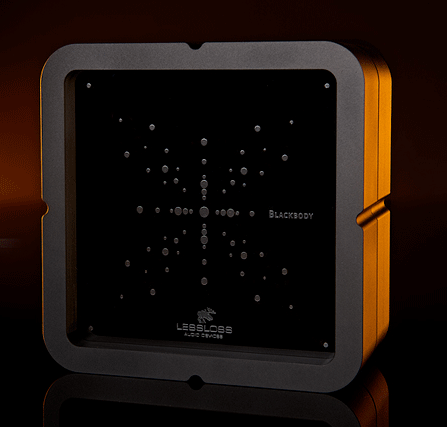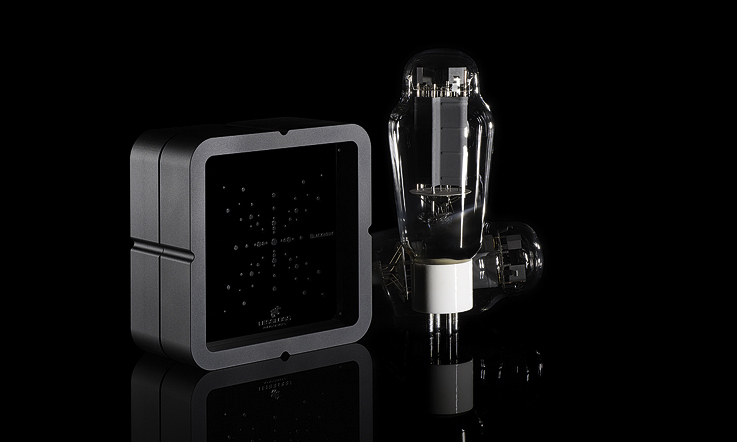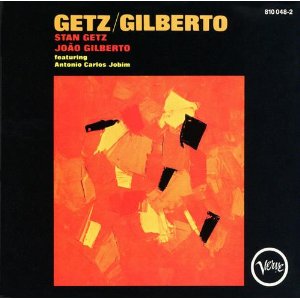The LessLoss Blackbody
| The LessLoss Blackbody |
| A Short Study in the Amazing |
|
|
|
July 2010 |

Liudas Motekaitis – anglicized as Louis Motek – managing director of LessLoss Audio Devices, tends to think outside the box, as they say. He is curious enough to pursue an idea which, to our Newtonian senses, may make no sense (and may even seem illogical). But it is practically an historical truism that sometimes the illogical seems illogical only because we don’t know enough about how things really work, or because our preconceptions get in the way. Thank goodness Mr Motek was able to step out of the rut of quotidian reality when he was driving past some crystal glass factories in Germany and heard the beneficial effect of their proximity on his car radio. This experience resulted, years later, in the Blackbody device.
In doing reviews I always make an effort to understand how things work, whether it has to do with quantization noise, micro-arcing, or, as in this case, the generation/absorption of energy at frequencies that just happen to have a subtle, yet profound effect on the purity of the reproduced signal. My efforts to understand haven’t been universally successful. For example, in the course of reviewing a rather sophisticated DAC, I found that working out the mathematics of adding dither to digital data didn’t after all improve my intuitive understanding of that essential process. I know it works, I can literally see the mathematical result, but I don’t really get it.
Mr Motek writes (here), “Quantum electrodynamics has established that photons in enormous numbers and at very low energy levels interacting with electrons account for what are called electromagnetic fields. Photons (regardless of wavelength) interacting with electrons likewise affect the electromagnetic fields in our gear, having a direct influence on signal quality. It is in this interaction that the LessLoss Blackbody functions.” By now many of us are comfortable with phenomena that can only be theorized about, not measured. Perhaps some of us use Shakti Stones or use one or more of Peter Belt’s unique applications. And theories as we’ve seen can fall by the wayside with the discovery of new data and new explanations. But for sure something’s going on when a Blackbody is placed in proximity to my equipment, and whatever it is, it is audible.
What we call reflection is (and counter-intuitively) the absorption and re-emittance of electromagnetic energy (electron-photon interaction in quantum electro-dynamic terms). This is potentially a bad thing when signal purity is an absolute priority, as it is in high-fidelity audio equipment. Not only is the energy that bounces back in different phase, but it is of a different wavelength or wavelengths. In addition to this, all electronic equipment generates ozone, proportionally to voltage and frequency, and ozone highly selective in its absorption and reflection of photons. As well, ozone is diamagnetic, that is, it resists the formation of magnetic fields. It is a highly undesirable substance to have around sensitive audio circuits. Louis Motek claims that the entire ecosystem of photochemistry around high fidelity sound systems is addressed by the Blackbody. “One needs only to spray pure oxygen into and all around well-warmed up gear to temporarily hear the utopian change in sound which is so very sought after and which has been so masterfully eluding our capture and control. The change in sound is due to the ambient photon-electron interplay.”In other words, by filling the space around electronic components with oxygen, which is not diamagnetic, ozone quickly breaks down into oxygen and ambient electromagnetic conditions are altered.
Mr Motek states that the Blackbody “…acts upon the electromagnetic radiation, specifically the ‘fingerprint’ of the statistical photon emission produced by audio equipment. It converts this photon radiation into a harmless photon gas without spectral content.” There is actually such a thing as photon gas and if you wish to delve into its properties and how they relate to blackbody radiation, check out Wikipedia. For our purposes, we can simply say that photons entering the Blackbody, rather like sunlight entering a greenhouse, bounce around and end up converted to heat. They do not produce typical reemission patterns. That is the unique property of the Blackbody (and where it gets its name), it absorbs rather than reflects photons. Otherwise when photons of one wavelength strike molecules – be they molecules of ozone or aluminum or steel – a reflection will result, and it will have the characteristic wavelengths of these materials. In simple terms, objects in proximity to audio gear have an influence on the sound. But if photon radiation from that gear can be reduced, reflections from those objects will be reduced, and greater signal purity will result.
In trying to picture these events is not clear to me where the causal line should be drawn, or even if. The phenomena Mr Motek is talking about are right out of quantum electrodynamics, and as Professor Feynman says, QED theory describes practically everything. It’s the damnedest thing, but what’s most important to us audiophiles is not theory of operation, but pragmatic result.
Day one. A noticeably heavy box arrives containing four LessLoss Blackbodies. Each has its own custom foam-lined box. I place two of them on my equipment rack. The other two are temporarily stored in another room in order to isolate them from the equipment. I want to hear what difference two make before deploying the remaining two, in part because the Blackbody is pretty pricey and there are many audiophiles living on a budget for whom one or two units might be the absolute financial limit. Later I will step up to four.
Day two. There are things going on here that I can’t explain, that challenge my fundamental preconceptions of how electronic devices work. And some of those challenging concepts turn out to be quite audible in my stereo but have nothing directly to do with circuit type or design or components or room treatments, things that normally ‘make a difference.’ We have irrevocably entered an age of man-made electromagnetic radiation with the blind confidence conferred by hubris. The local Whole Foods market proudly inundates us health-oriented shoppers with WiFi, as if even momentary separation from the internet were traumatic or unconstitutional. Our living rooms are no exception. If we could actually see these wavelengths, we’d be claustrophobic. The notion that this sea of radiation affects electronic equipment is plausible. The notion that internal radiation from that equipment can not only bounce back randomly in different phase but can stimulate nearby objects to generate their own frequencies, seems somewhat less intuitively plausible. And the notion that a passive device like the Blackbody somehow alters these effects may even seem far-fetched. Snide and cynical comments on the internet about the Blackbody by those who have not even heard it in action attest to this. But theory notwithstanding, two Blackbodies in close proximity to two front-end electronic devices in my stereo produced an immediate and obvious improvement to the sound. This is only the second day since the Blackbodies arrived, no “objective” testing has been attempted, I’ve not tried to “prove” (or disprove) anything. Nor, as it turned out, did I try to do so for quite some time.

A ‘field filtering device.’ That’s what Louis Motek calls his Blackbody, in distinction of various power filtering devices. It’s a beautifully designed, alloy and glass package, 4.75 inches square by 2.375 inches deep, weighing nearly five pounds, with engraved opaque glass panels forming a cavity with both a non-active side and an active side. Whatever is inside this cavity works without external power sources and has an effective angle of 35 degrees, which Mr Motek analogously compares to the beam from a flashlight, being careful to note that nothing actually radiates from the Blackbody. (I found it conceptually easier to think of this angle like the angle of incidence of a lens.) Effectiveness of course diminishes with distance, just like a flashlight. Ideally a Blackbody should be far enough away so that the equipment is subsumed by a 35 degree angle. I do not have this luxury, with only a couple of inches of shelf space to play with. So I have placed one unit toward the front of the external power supply (Bel Canto VBS) and one unit toward the rear of the digital converter (Bel Canto DAC3). If there is a certain logic in the latter position, it is because the analog circuitry in the DAC is generally toward the rear of the chassis where the output connections are located. Moreover, offsetting the two Blackbodies, one toward the front, the other toward the rear, provides greater coverage of both units.
What’s it sound like? I tend to think of my own system as quite decent though limited, particularly the loudspeakers, which are priced at the low-moderate end of the price spectrum and roll off at 40 Hz. Which I suppose is why, when I look for a snappy description of the changes I heard when the Blackbodies were put in place, I’m apt to say something like, It’s as if I have a new pair of loudspeakers. That may be a bit extreme, but there is something compelling and engaging about the change in the sound. Descriptions of subtle changes in the sound are bound to be inexact and somewhat metaphorical, but in my experience as a reviewer describing the Blackbody effect is especially elusive.
Everything is the same, same amplifiers, same front end, same loudspeakers, same cables, same isolation devices, and yet this stereo has a significantly different character, and its one I like a hell of a lot. I continually find myself stopping in my tracks, noticing nuances and details and ambiance I don’t recall, basking in a sense of presence and spaciousness that is delightful and surprising. There is a crystalline clarity about the highs, and bass feels more accurate and substantial. Listening is relaxed and easy, never fatiguing, and very satisfying. Clarity, clarity, clarity. Transient attacks to die for. Listen to the hammers strike the piano strings, felt covered wood hammers hitting metal strings, clear as a bell. Listen to the tactility of rosin-covered horse hair drawing across the ‘cello strings. Listen to the rich, clear layering of overtones in a singer’s voice. It’s enough to give one goose bumps at times.
 Brahms, Variations: “Schumann,” “Handel,” “Paganini,” Idil Biret, piano (Naxos 8.550350). This is extraordinary: nighttime, I can almost see the pianist at the keyboard, as if I am in the room with her. Her love for this music is so obvious, her reaching out to fathom its undying soul. Although over the years this has not been my favorite performance of these variations (I have gravitated toward Julius Katchen), the sheer excitement, the lush delight of this heightened sense of presence, is captivating. And regardless of what may be felt to be lacking in her technique, Ms Biret offers a singularly pure vision. The words, if there are words to capture this experience, elude me. As a reviewer I spend time listening to equipment, but when equipment does its job this well, it transcends itself, it becomes a clear vessel for the music, a doorway to the heart and soul of the composer and performer. I have always considered the real purpose of all art to be delight, and I think never before has this stereo so fulfilled that purpose.
Brahms, Variations: “Schumann,” “Handel,” “Paganini,” Idil Biret, piano (Naxos 8.550350). This is extraordinary: nighttime, I can almost see the pianist at the keyboard, as if I am in the room with her. Her love for this music is so obvious, her reaching out to fathom its undying soul. Although over the years this has not been my favorite performance of these variations (I have gravitated toward Julius Katchen), the sheer excitement, the lush delight of this heightened sense of presence, is captivating. And regardless of what may be felt to be lacking in her technique, Ms Biret offers a singularly pure vision. The words, if there are words to capture this experience, elude me. As a reviewer I spend time listening to equipment, but when equipment does its job this well, it transcends itself, it becomes a clear vessel for the music, a doorway to the heart and soul of the composer and performer. I have always considered the real purpose of all art to be delight, and I think never before has this stereo so fulfilled that purpose.
 Sviatoslav Richter in Concert (Brilliant Classics 9229/1-5). Richter preferred small venues and live audiences to studios, so – unfortunately for us – a relatively small percentage of his recordings are of excellent sound quality. Problems with these field recordings include, but are not limited to, audience coughs and shuffling, shrunken dynamics, limited frequency response, distortion, poor microphone placement and poor recording quality. The mere existence of Richter’s famous Sophia Pictures at an Exhibition is a fluke; someone in the audience had a cheap battery-operated tape recorder. The sound quality is horrid, the performance, amazing. Schubert’s posthumous D960 sonata in this particular set is of decent sound quality, but only just. However, with the Blackbodies there is noticeably greater nuance and a more realistic recreation of the event. I might add here that I’ve noticed this effect with other sonically challenged CDs as well. For example, Germaine Thyssens-Valentin’s performance of Faure’s Barcarolles recorded at Salle Adyar in Paris in 1956 (Testament SBT 1215). Thyssens-Valentin gave up her career when she had children, picked it up some twenty years later when they were grown. And a good thing: her performance of Faure’s music seems to me inspired and impeccable, and despite limited frequency response and dynamics, they are stunning. The sense of reality of the piano is distinctly enhanced by the Blackbody.
Sviatoslav Richter in Concert (Brilliant Classics 9229/1-5). Richter preferred small venues and live audiences to studios, so – unfortunately for us – a relatively small percentage of his recordings are of excellent sound quality. Problems with these field recordings include, but are not limited to, audience coughs and shuffling, shrunken dynamics, limited frequency response, distortion, poor microphone placement and poor recording quality. The mere existence of Richter’s famous Sophia Pictures at an Exhibition is a fluke; someone in the audience had a cheap battery-operated tape recorder. The sound quality is horrid, the performance, amazing. Schubert’s posthumous D960 sonata in this particular set is of decent sound quality, but only just. However, with the Blackbodies there is noticeably greater nuance and a more realistic recreation of the event. I might add here that I’ve noticed this effect with other sonically challenged CDs as well. For example, Germaine Thyssens-Valentin’s performance of Faure’s Barcarolles recorded at Salle Adyar in Paris in 1956 (Testament SBT 1215). Thyssens-Valentin gave up her career when she had children, picked it up some twenty years later when they were grown. And a good thing: her performance of Faure’s music seems to me inspired and impeccable, and despite limited frequency response and dynamics, they are stunning. The sense of reality of the piano is distinctly enhanced by the Blackbody.
 Stan Getz, Joao Gilberto:Getz/Gilberto (Verve D118689). I can, more or less, accept the proposition that the “effect” of the Blackbody cannot be measured. I can accept my conceptual and intellectual limitations in comprehending Mr Motek’s description of how the Blackbody works. But I’d dearly love to know just what changes are taking place in the audio signal itself, and I wonder that it cannot – no more than the effect of a power cord – be detected by measuring instruments. Maybe some day, but right now our ears seem to be the supreme detectors. I’ve heard this CD dozens of times, it always sounds good. But I haven’t always walked around with goose bumps. The difference is elusive (that word again); perhaps I too am looking in the wrong places, but the response of my body and emotions are not to be gainsaid and they suggest something special and unprecedented is taking place in the reproduction of this music.
Stan Getz, Joao Gilberto:Getz/Gilberto (Verve D118689). I can, more or less, accept the proposition that the “effect” of the Blackbody cannot be measured. I can accept my conceptual and intellectual limitations in comprehending Mr Motek’s description of how the Blackbody works. But I’d dearly love to know just what changes are taking place in the audio signal itself, and I wonder that it cannot – no more than the effect of a power cord – be detected by measuring instruments. Maybe some day, but right now our ears seem to be the supreme detectors. I’ve heard this CD dozens of times, it always sounds good. But I haven’t always walked around with goose bumps. The difference is elusive (that word again); perhaps I too am looking in the wrong places, but the response of my body and emotions are not to be gainsaid and they suggest something special and unprecedented is taking place in the reproduction of this music.
 Beethoven: String Quartet Op 127, Talich Quartet (Calliope CAL 3633.9) This is from the first set of Beethoven quartets I bought in CD format. Before this, I had only the classic 1950 vinyl series by the Budapest String Quartet, discs I had started collecting when I was eighteen and heavily under the influence of J.W.N. Sullivan’s Beethoven: His Spiritual Development. And if it is true – as my ears tell me – that certain CDs sound better reproduced through certain equipment and loudspeakers, then this one is an absolute natural with this stereo. I did not take to the sound of these CDs initially, there was something dry and uninvolving about them; but as my system slowly improved (and perhaps as my taste matured as well) over the years, so did my regard for the musicianship and sound engineering. This, however, is no less than stunning, perhaps the most improved sound I’ve heard with the Blackbodies. It is certainly the most satisfying portrayal of a live string quartet I’ve experienced. Same sorts of things I’ve been talking about, only more so. Presence, clarity, nuance, tactility. More meat on the bone.
Beethoven: String Quartet Op 127, Talich Quartet (Calliope CAL 3633.9) This is from the first set of Beethoven quartets I bought in CD format. Before this, I had only the classic 1950 vinyl series by the Budapest String Quartet, discs I had started collecting when I was eighteen and heavily under the influence of J.W.N. Sullivan’s Beethoven: His Spiritual Development. And if it is true – as my ears tell me – that certain CDs sound better reproduced through certain equipment and loudspeakers, then this one is an absolute natural with this stereo. I did not take to the sound of these CDs initially, there was something dry and uninvolving about them; but as my system slowly improved (and perhaps as my taste matured as well) over the years, so did my regard for the musicianship and sound engineering. This, however, is no less than stunning, perhaps the most improved sound I’ve heard with the Blackbodies. It is certainly the most satisfying portrayal of a live string quartet I’ve experienced. Same sorts of things I’ve been talking about, only more so. Presence, clarity, nuance, tactility. More meat on the bone.
Let the tests begin. Today I conducted my first A/B experiment, not under any illusion that anything about the Blackbody effect can be proven, but in order to add a layer of objectivity to my – thus far – purely subjective experience. Due to their portability and the fact that the Blackodies have no physical or electrical connection to any of the equipment, doing A/B testing was straightforward. I began with the first movement of Beethoven’s Opus 10, No 1 sonata(Gerard Willems, piano, ABC Classics 465 077-2). I chose this CD because of the extraordinarily sonorous and articulate Stuart & Sons piano used for the sessions, plus the fact the recording is close mic’d. I’ve written about this set of CDs and this pianoforte before (here). When I played the Allegro molto a second time with the Blackbodies removed to another room, something changed. Something – I don’t quite know how to describe it – was missing. You might call it presence, or body or fullness. Particularly since this was a fully sighted test, I made a conscious effort to be scrupulous about mental prejudices and expectations, but there seems to be no doubt about it. A certain substantiality and palpability left the music when the Blackbodies left the room. I carried out this procedure with various CDs and although I found some variation in the perceived amount of difference, the presence or absence of the Blackbodies was always noticeable. Later I brought out the second pair of Blackbodies and positioned them as I had the first two, but in proximity to my two monoblock amplifiers (Bel Canto REF1000 MkIIs). There was a significant improvement in the sound, along the lines I’ve already attempted to describe.
While the Blackbodies did not, on this particular stereo, offer as much improvement as my first encounter with non-OEM power cords did (also by LessLoss), could I afford them, I would not be without their magic. Indeed, could I afford them, I’d have a pair of these beauties treating each piece of my electronic gear. And there is absolutely no question in my mind that my enjoyment of music would be distinctly the better for it. Bear in mind, LessLoss offers a 30-day trial period and discounts on the purchase of multiple units.

![]()
Price: $959.00 each
2 units – 12% off ($844 each, you save $230)
3+ units – 15% off ($815 each, you save $432+)
Free UPS shipping! All prices include international
Contact Us:
LessLoss Audio Devices
P.D. 1231
46005 Kaunas
Lithuania
Phone: +370 698 48706
Phone: +370 37 390515
USA: +1 (310) 801-7089
Website: www.lessloss.com
Email: info@lessloss.com (Your contact is Louis Motek. I’ll be happy to hear from you.)
Skype: liudasliudas
![]()
Don’t forget to bookmark us! (CTRL-SHFT-D)
Stereo Times Masthead
Publisher/Founder
Clement Perry
Editor
Dave Thomas
Senior Editors
Frank Alles, Mike Girardi, Russell Lichter, Terry London, Moreno Mitchell, Paul Szabady, Bill Wells, Mike Wright, and Stephen Yan,
Current Contributors
David Abramson, Tim Barrall, Dave Allison, Ron Cook, Lewis Dardick, John Hoffman, Dan Secula, Don Shaulis, Greg Simmons, Eric Teh, Greg Voth, Richard Willie, Ed Van Winkle, Rob Dockery, Richard Doron, and Daveed Turek
Site Management Clement Perry
Ad Designer: Martin Perry





Be the first to comment on: The LessLoss Blackbody